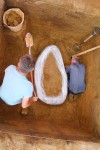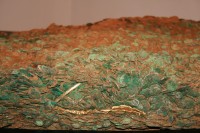 The world’s largest Iron Age coin hoard, discovered on Jersey nine years ago, has been acquired by the Government of Jersey for £4.25 million ($5.7 million). The Council of Ministers dipped into the civil asset recovery fund (moneys confiscated from criminal activities) to pay Her Majesty’s Receiver General, administrator of the Crown estate in Jersey, for the right to keep their own patrimony.
The world’s largest Iron Age coin hoard, discovered on Jersey nine years ago, has been acquired by the Government of Jersey for £4.25 million ($5.7 million). The Council of Ministers dipped into the civil asset recovery fund (moneys confiscated from criminal activities) to pay Her Majesty’s Receiver General, administrator of the Crown estate in Jersey, for the right to keep their own patrimony.
 The Le Catillon II hoard was discovered by a pair of metal detectorists in February 2012. They had been searching that field for 30 years, looking for a coin treasure based on a tale they’d heard from the previous landowner’s daughter that she and her father had found coins in a jar buried in the field when she was a little girl. After three decades of fruitless searching, Reg Mead and Richard Miles found 60 coins of the Coriosolite tribe in what is now Brittany in one location. They dug down and encountered the top of what would prove to be a massive group of Celtic coins.
The Le Catillon II hoard was discovered by a pair of metal detectorists in February 2012. They had been searching that field for 30 years, looking for a coin treasure based on a tale they’d heard from the previous landowner’s daughter that she and her father had found coins in a jar buried in the field when she was a little girl. After three decades of fruitless searching, Reg Mead and Richard Miles found 60 coins of the Coriosolite tribe in what is now Brittany in one location. They dug down and encountered the top of what would prove to be a massive group of Celtic coins.
The find site was then thoroughly excavated by archaeologists who wrapped the mass of coins, hardened by corrosion into a half-ton block, and raised it in one giant chunk for excavation at the Jersey Museum in view of  the public. Initial estimates of how many coins were crammed in there ranged from 30,000 to 50,000. As excavation continued, the estimate increased to 70,000; this turned out to be the accurate figure. Conservators then encountered a surprise: a section about the size of a shoebox containing six gold torcs. They also found other pieces of jewelry, glass beads, a leather purse and a woven bag containing silver and gold jewelry. It took five years to fully excavate the block. The last coin was removed in 2017.
the public. Initial estimates of how many coins were crammed in there ranged from 30,000 to 50,000. As excavation continued, the estimate increased to 70,000; this turned out to be the accurate figure. Conservators then encountered a surprise: a section about the size of a shoebox containing six gold torcs. They also found other pieces of jewelry, glass beads, a leather purse and a woven bag containing silver and gold jewelry. It took five years to fully excavate the block. The last coin was removed in 2017.
Treasure finds on Jersey are legally complicated because of its status as a self-governing Crown Dependency. The finders wanted the Le Catillon II hoard declared treasure under the UK’s legislation or, if the French law was applied, that it belonged to the finders and landowner. They tried to make a case of it, to loosen up the Crown Dependency chains a little bit, but nothing came of it, and a decade later it came down to a buyout. The hoard’s value was initially estimated at £10 million, so at least they got charged the friends price.
The historic collection of coins will now remain in Jersey Heritage’s care.
Part of the financial settlement included a £250,000 payment to Jersey Heritage for their work towards dismantling the coins, and an additional £250,000 which will be used to establish a trust. […]
The Crown will now undertake the work to establish an independent trust to promote scientific and educational research into the historic discovery.
Chief Minister John Le Fondre said the purchase was made “in the interest of the island”.
He said: “This is an outcome which will ensure that this unique part of Jersey’s history remains in the island for this and future generations.”